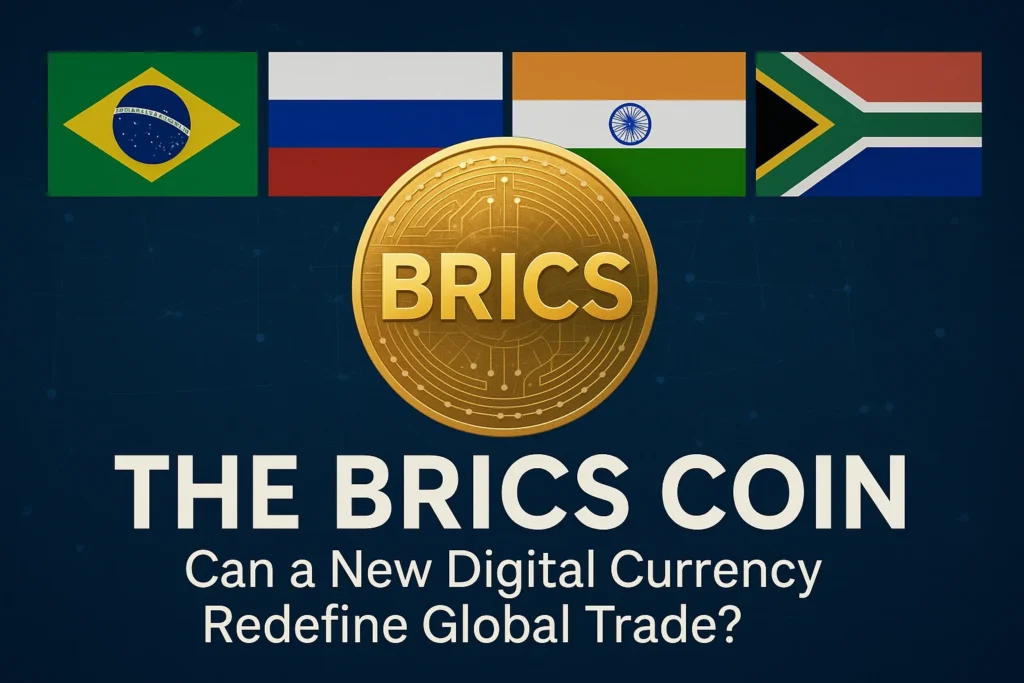For decades, the global financial system has revolved around a single axis: the US dollar. From international trade to central bank reserves, the greenback has held unparalleled dominance, granting the United States immense geopolitical and economic leverage. But beneath this seemingly unshakeable foundation, tectonic plates are shifting. A powerful bloc of emerging economies – Brazil, Russia, India, China, and South Africa, collectively known as BRICS – has been increasingly vocal about its desire to reshape this financial order. Their ambition? To reduce reliance on the US dollar and build a more multipolar global economy, a vision that increasingly points towards the creation of new, potentially digital, financial instruments.
While a fully launched “BRICS Coin” is not yet a reality, the discussions, explorations, and foundational steps being taken by these nations are making waves. They are actively seeking ways to facilitate trade among themselves in local currencies, develop alternative payment systems, and even conceptualize a future common currency that could leverage advanced technologies like blockchain. This isn’t just about economic convenience; it’s a strategic move in a new geopolitical chess game, one that could redefine how global trade is conducted and how financial power is distributed.
The Quest for Financial Independence: Why BRICS Seeks Alternatives
The motivations behind BRICS nations’ push for alternatives to the US dollar are multifaceted, stemming from both economic pragmatism and geopolitical realities:
- De-dollarization Efforts: At the forefront is the desire to reduce systemic reliance on the US dollar. This “de-dollarization” is driven by several factors, including the dollar’s volatility, its influence on inflation in other economies, and the perceived vulnerability to US monetary policy.
- Mitigating Sanctions Risk: The weaponization of financial systems, particularly the use of dollar-based sanctions by the US, has demonstrated the vulnerability of nations highly dependent on the dollar and the SWIFT messaging system. BRICS members, some of whom have faced or fear such sanctions (like Russia and Iran, now a new member), seek resilient alternatives to protect their economies and sovereignty.
- Enhancing Trade Efficiency: Settling trade in local currencies or through a new common mechanism can reduce transaction costs, currency conversion risks, and delays. For a bloc representing a significant portion of the world’s population and economic output, streamlining intra-bloc trade is a key economic driver.
- Promoting Multipolarity: The BRICS group champions a more balanced global order, one that reflects the growing economic power of emerging markets. Creating independent financial infrastructure is a crucial step towards achieving this multipolar vision and asserting greater influence in global governance.
- Financial Stability: Diversifying away from a single dominant currency can provide greater stability for international reserves and reduce exposure to external economic shocks or policy changes originating from one nation.
These factors converge to create a powerful incentive for BRICS nations to explore innovative solutions that could fundamentally alter global financial flows.
Beyond the Dollar: The Vision for a BRICS Payment System
While the idea of a fully-fledged “BRICS Coin” captures headlines, the more immediate and concrete efforts by the bloc focus on developing a robust common payment system. This system aims to facilitate seamless cross-border transactions among member states, allowing them to settle trade and investments directly in local currencies or via a new, neutral financial instrument, thereby bypassing traditional Western-dominated financial infrastructure like the SWIFT network.
This initiative is often referred to as “Bridge” or “BRICS Pay.” The concept behind such a system is to:
- Enable Direct Local Currency Settlements: Instead of converting currencies through the US dollar, a Brazilian company could pay an Indian company directly in Indian Rupees or Brazilian Reals, reducing intermediary costs and foreign exchange risks.
- Create a Secure Messaging Layer: Similar to SWIFT but controlled by BRICS nations, a new messaging system would ensure secure and efficient communication for financial transactions. This would provide an independent channel, less susceptible to external geopolitical pressures.
- Facilitate Multilateral Clearing: The system would likely involve a mechanism for clearing and settling transactions among member states, potentially through a network of central banks or designated financial institutions.
Discussions around “BRICS Pay” have been ongoing, with various technical and operational models being explored. It’s a pragmatic step that acknowledges the complexities of a unified currency but still achieves the goal of reducing dollar dependence in intra-bloc trade. This payment system would not necessarily replace national currencies but would act as a neutral conduit, making cross-border payments faster, cheaper, and more resilient for BRICS members.
Digital Bridges: The Role of Blockchain and CBDCs
The discussions around BRICS’s financial alternatives are deeply intertwined with the rise of digital technologies, particularly blockchain and Central Bank Digital Currencies (CBDCs). While a singular BRICS digital currency isn’t launched, these technologies offer compelling pathways for their goals.
Many BRICS nations are at the forefront of CBDC development:
- China’s Digital Yuan (e-CNY): China is a leader in CBDC implementation, with its digital yuan already in pilot programs across various cities, setting a precedent for large-scale digital currency adoption.
- India’s Digital Rupee (e₹): India has launched its own wholesale and retail CBDC pilots, the e₹, showcasing its interest in leveraging digital currencies for domestic payments and potentially cross-border transactions.
- Brazil’s DREX: Brazil is also advancing with its digital real project, DREX, aiming to modernize its financial infrastructure and improve efficiency.
- Russia and South Africa: Both nations are also actively exploring their own CBDCs, the Digital Ruble and Project Khokha, respectively.
The key lies in interoperability. Instead of creating one new BRICS digital currency, a more feasible and immediate approach involves connecting these national CBDCs or existing digital payment rails. Blockchain technology could serve as the underlying distributed ledger for such a connection, facilitating seamless, atomic (instant and irreversible) cross-border payments without relying on traditional correspondent banking networks. This “bridge” could allow direct transfers between, say, India’s e₹ and China’s e-CNY, significantly improving speed and reducing costs.
This approach aligns with the global trend of exploring CBDC interoperability for efficient cross-border payments, as seen in projects like “Project Dunbar” or “mBridge” (which includes China, Hong Kong, Thailand, and UAE). BRICS could build upon such concepts to create a more resilient and independent digital payment backbone for its members.
A Basket of Influence: The Concept of a Common Currency (Future Vision)
Beyond a common payment system, the ambitious long-term vision within BRICS is the creation of a common currency. This idea, while still largely theoretical and fraught with significant challenges, represents the ultimate goal of true financial independence and a unified economic front.
Several models for such a currency have been floated:
- Commodity-Backed Currency: Given that BRICS nations are significant producers of commodities (oil, gas, minerals, agricultural products), some proposals suggest a common currency could be backed by a basket of key commodities. This would lend it inherent value and potentially make it more stable than fiat currencies.
- Basket of Currencies: Another idea is a currency whose value is derived from a basket of BRICS members’ national currencies, similar to the IMF’s Special Drawing Rights (SDR). This would reflect the collective economic strength of the bloc.
- Digital Unit of Account: Initially, it might not be a physical currency but a digital unit of account used solely for trade settlement between central banks, effectively acting as a clearing mechanism before eventually evolving into a transferable digital asset.
The theoretical benefits of a truly common BRICS currency are immense: it could eliminate exchange rate risks in intra-bloc trade, foster deeper economic integration, and potentially evolve into a reserve asset for central banks outside the traditional dollar-euro-yen framework. However, this is a highly complex undertaking, requiring unprecedented levels of economic alignment and political trust among diverse nations.
The New Members, The New Momentum: BRICS+ and De-dollarization
The recent expansion of BRICS has significantly amplified its voice and potential influence in the global financial arena. With the addition of Egypt, Ethiopia, Iran, Saudi Arabia, and the United Arab Emirates (UAE) in early 2024, the bloc now represents an even larger share of the world’s population, GDP, and, critically, energy production and consumption.
- Increased Economic Clout: The expanded BRICS+ now includes major oil producers (Saudi Arabia, UAE, Iran, Russia) and large energy consumers (China, India), giving it substantial leverage in global commodity markets. This strengthens the argument for settling energy trade in non-dollar currencies or a new BRICS-backed instrument.
- Geographical Reach: The new members extend BRICS’s footprint across the Middle East and Africa, making its de-dollarization agenda resonate with a broader range of developing nations seeking greater financial autonomy.
- Diverse Economies: While adding complexity, the new members also bring diverse economic strengths and trade flows, further enhancing the potential scope and utility of a BRICS payment system.
The expanded membership means that any successful alternative payment or currency system developed by BRICS would immediately gain significant traction, impacting a much larger volume of global trade and investment. This growing coalition signifies a collective resolve to build a more diversified and less dollar-centric financial future.
Hurdles on the Horizon: The Complexities of Economic Convergence
The ambition of a BRICS common currency or a highly integrated digital payment system is immense, but so are the hurdles. These challenges are not merely technical; they are deeply rooted in economics, geopolitics, and governance:
- Economic Disparities: BRICS members represent vastly different economic sizes, structures, and levels of development. China is an economic superpower, while South Africa and Ethiopia are much smaller. Harmonizing monetary policies, inflation targets, and economic priorities to support a common currency would be incredibly difficult.
- Trust and Governance: Creating a common currency or even a universally trusted payment system requires a high degree of mutual trust and a robust, impartial governance structure. Who would manage this currency? Which central bank or new institution would oversee its issuance and stability? Ensuring fairness and preventing any single nation from dominating the system would be paramount.
- Convertibility and Acceptance: For any new currency or digital unit to gain widespread acceptance, it must be freely convertible and widely accepted for a variety of transactions, not just trade among BRICS members. This requires global confidence, which takes time and strong economic fundamentals.
- Regulatory Harmonization: Each BRICS nation has its own financial regulations, legal frameworks, and digital currency laws. Aligning these diverse regulatory environments for a shared digital financial instrument would be a monumental task.
- Capital Controls: Some BRICS nations maintain strict capital controls (e.g., China), which could complicate the free flow of a common currency or digital asset.
- Technological Integration: While blockchain offers promise, scaling a robust, secure, and efficient blockchain network capable of handling the transaction volume of major international trade among multiple nations is a significant technical challenge.
- Resistance from Established Powers: Any serious move to undermine the dollar’s dominance would inevitably face resistance from the US and its allies, potentially leading to counter-measures or geopolitical friction.
These challenges mean that any shift will be gradual, likely starting with incremental steps like local currency trade and integrated payment systems, rather than an immediate launch of a common currency.
Impact on the Global Stage: Redrawing the Financial Map
Even if a full “BRICS Coin” is a long-term aspiration, the bloc’s concerted efforts towards de-dollarization and alternative financial architecture are already having a noticeable impact on the global stage:
- Weakening Dollar Dominance (Gradual): While the US dollar’s position as the world’s primary reserve and trade currency remains strong, BRICS’s actions contribute to a gradual erosion of its dominance. As more trade settles in local currencies or through alternative systems, the demand for dollars in international transactions could slowly decrease.
- Challenges to SWIFT: The push for alternative payment systems like “Bridge” directly challenges the supremacy of SWIFT, which is seen by many nations as being too susceptible to geopolitical influence. A viable BRICS payment network could offer a parallel system, providing greater options and resilience.
- Rise of Regional Currencies: The focus on local currency trade within BRICS implicitly promotes the internationalization of member states’ own currencies, such as the Indian Rupee, Chinese Yuan, and Russian Ruble, within their respective trade networks.
- Increased Multilateralism: BRICS’s financial initiatives are a manifestation of a broader trend towards multilateralism and away from a unipolar global order. It signals a desire among emerging economies to have a greater say in shaping global economic rules and institutions.
- Innovation in Fintech: The very act of exploring blockchain and CBDC interoperability for cross-border payments drives innovation in fintech, potentially leading to more efficient, transparent, and resilient payment solutions for the entire global economy.
The financial world is complex and deeply interconnected. Any significant shift will take decades, but BRICS’s current trajectory undeniably marks a move towards a more diversified and potentially multipolar global financial architecture, where the dollar might eventually share the stage with other powerful currencies or digital instruments.
The Road Ahead: Incremental Steps Towards a New Order
The narrative around a “BRICS Coin” often overshadows the pragmatic, incremental steps the bloc is actually taking. Rather than a sudden unveiling of a new global currency, the more likely path forward involves:
- Expanding Local Currency Trade: Continuing to increase the volume of trade settled directly in national currencies among BRICS members and their trading partners.
- Developing the BRICS Payment System: Investing in and rolling out the “Bridge” or “BRICS Pay” system to enable more efficient and secure cross-border transactions outside the traditional Western financial rails. This is the most tangible ongoing effort.
- Enhancing CBDC Interoperability: Building technical bridges and agreements to allow direct, seamless transactions between the CBDCs of member states, further streamlining digital payments.
- Strengthening BRICS Development Bank (NDB): Leveraging the New Development Bank as a key financial institution to facilitate lending and investment in local currencies, reducing dependence on dollar-denominated loans.
- Gradual Accumulation of Alternative Reserves: Central banks within BRICS and friendly nations may slowly increase their holdings of non-dollar denominated assets, including other BRICS currencies or gold.
These steps, though less dramatic than a “BRICS Coin” launch, represent a steady and strategic chipping away at dollar dominance, building foundational infrastructure for a future where global finance is more balanced and resilient.
Conclusion: A Multipolar Financial Future?
The notion of a “BRICS Coin” captures the imagination, symbolizing a dramatic shift in global financial power. While a unified, blockchain-powered currency from BRICS is not yet a reality, the bloc’s relentless pursuit of de-dollarization and alternative financial mechanisms is undeniable. Fueled by geopolitical realities and a shared vision for a multipolar world, BRICS nations are actively working towards building a more independent and resilient financial architecture.
Their efforts are currently focused on establishing robust, alternative payment systems that leverage local currencies and explore the potential of interoperable Central Bank Digital Currencies. These pragmatic steps, rather than a single grand launch, are steadily reshaping trade finance and challenging the long-held supremacy of the US dollar. The expanded BRICS+ membership further strengthens this resolve, creating a formidable alliance with significant economic and geopolitical weight.
The global financial map is not being redrawn overnight, but the contours of a new, more diversified landscape are becoming clearer. As BRICS nations continue to build their digital bridges and strengthen their financial ties, the world watches to see if their collective ambition can indeed usher in a multipolar financial future, where power and prosperity are more evenly distributed across the globe.



